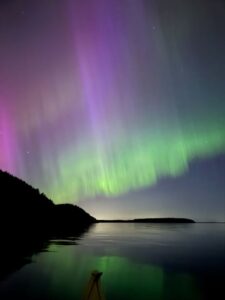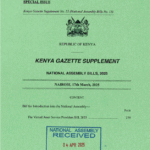A mesmerising display of auroras has captivated skywatchers around the globe, as a recent solar storm unleashed a celestial spectacle of vibrant colours across both the Southern African skies and the Northern Hemisphere. The awe-inspiring phenomenon, fuelled by a coronal mass ejection (CME) from the Sun, interacted with Earth’s magnetic field, igniting geomagnetic storms of varying intensities and paving the way for the appearance of the Aurora Australis (Southern Lights) and the Aurora Borealis (Northern Lights).
Reports from various regions have documented the breathtaking beauty of the auroras, with vivid hues dancing across the night sky, casting an ethereal glow that mesmerised observers. In Southern Africa, where auroras are a rare sight, the celestial display marked a historic event, drawing crowds of spectators and photographers to witness the spectacle first-hand.
The significance of the recent solar storm event extends beyond its visual splendor, serving as a stark reminder of the potential impacts on technological infrastructure and the importance of space weather monitoring and preparedness. Geomagnetic storms, such as those induced by solar activity, can disrupt satellite communications, navigation systems, and power grids, posing risks to both critical infrastructure and everyday technologies.
Space agencies and meteorological organizations have been closely monitoring solar activity and its potential effects on Earth, employing advanced forecasting techniques to anticipate and mitigate the impacts of space weather events. However, the unpredictability of solar storms underscores the need for continued vigilance and investment in space weather research and monitoring capabilities.
As the world marvels at the celestial ballet of auroras painted across the night sky, scientists and policymakers emphasize the imperative of bolstering resilience against the potential disruptions posed by solar storms. By enhancing our understanding of space weather dynamics and implementing robust mitigation strategies, we can safeguard critical infrastructure and ensure the uninterrupted functioning of modern technological systems in the face of solar turbulence.

The science behind the phenomenon
The captivating phenomenon of auroras, known as the Aurora Borealis (Northern Lights) in the Northern Hemisphere and the Aurora Australis (Southern Lights) in the Southern Hemisphere, is a result of complex interactions between solar particles and Earth’s atmosphere. Here’s a breakdown of the science behind auroras:
Solar Activity:
Auroras are primarily triggered by solar activity, particularly coronal mass ejections (CMEs) and solar flares, which release massive amounts of charged particles (mainly electrons and protons) from the Sun’s atmosphere into space. This phenomenon is part of the solar cycle, which follows an approximately 11-year pattern of increased and decreased solar activity.
Solar Wind and Magnetosphere Interaction:
The stream of charged particles released by the Sun, known as the solar wind, travels through space and interacts with Earth’s magnetosphere, the region surrounding the planet controlled by its magnetic field. Earth’s magnetic field deflects most of the solar wind, but some particles are trapped and guided towards the polar regions.
Entry into Earth’s Atmosphere:
As the charged particles from the solar wind approach Earth’s atmosphere near the polar regions, they collide with gas molecules, primarily oxygen and nitrogen, in the atmosphere. These collisions transfer energy to the gas molecules, causing them to become excited.
Excitation and Emission of Light:
Excited gas molecules in Earth’s atmosphere release the absorbed energy in the form of light. Oxygen molecules emit green and red light when excited, while nitrogen molecules emit blue and purple light. The specific colours produced depend on the altitude at which the collisions occur and the type of gas molecules involved.
Formation of Auroras:
The collective emission of light from the excited gas molecules creates the dazzling display of auroras, characterised by vibrant curtains, arcs, or bands of light that dance across the night sky. The patterns and colours of auroras vary depending on factors such as altitude, the composition of the atmosphere, and the intensity of solar activity.
Polar Regions:
Auroras are predominantly visible near the Earth’s polar regions, where the magnetic field lines converge towards the magnetic poles. This concentration of magnetic field lines increases the likelihood of interactions between solar particles and the atmosphere, resulting in more frequent and intense auroral displays.
Overall, auroras are a mesmerising manifestation of the dynamic relationship between the Sun, Earth’s magnetic field, and the atmosphere, offering a stunning visual reminder of the interconnectedness of celestial phenomena.













